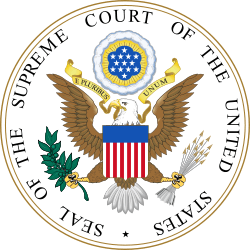McCullen v. Coakley
| McCullen v. Coakley | |||||||
|---|---|---|---|---|---|---|---|
|
| |||||||
| Argued January 15, 2014 Decided June 26, 2014 | |||||||
| Full case name | Eleanor McCullen, et al., Petitioners v. Martha Coakley, Attorney General of Massachusetts, et al. | ||||||
| Docket nos. | 12-1168 | ||||||
| Citations | |||||||
| Court membership | |||||||
| |||||||
| Case opinions | |||||||
| Majority | Roberts, joined by Ginsburg, Breyer, Sotomayor, Kagan | ||||||
| Concurrence | Scalia, joined by Kennedy, Thomas | ||||||
| Concurrence | Alito | ||||||
| Laws applied | |||||||
| U.S. Const. amend. I | |||||||
McCullen v. Coakley, 573 U.S. ___ (2014), was a United States Supreme Court case. The Court unanimously held that Massachusetts' 35-feet fixed abortion buffer zones, established via amendments to that state's Reproductive Health Care Facilities Act, violated the First Amendment to the U.S. Constitution because it limited free speech too broadly.
Background
Massachusetts' Reproductive Health Care Facilities Act, originally passed in 2000, was amended in 2007 to create a 35-foot buffer zone around reproductive health care facilities. The Act was challenged by protesters at the Planned Parenthood clinics in Boston, Worcester, and Springfield, Massachusetts under the First and Fourteenth Amendments.
Opinion of the Court
Chief Justice John Roberts delivered the opinion of the Court, writing that, "The buffer zones burden substantially more speech than necessary to achieve Massachusetts' asserted interests."[1] He stated that Massachusetts failed to show that it tried less intrusive alternatives first:
- Although respondents claim that Massachusetts 'tried other laws already on the books', they identify not a single prosecution brought under those laws within at least the last 17 years. And while they also claim that the Commonwealth 'tried injunctions', the last injunctions they cite date to the 1990s. In short, the Commonwealth has not shown that it seriously undertook to address the problem with less intrusive tools readily available to it. Nor has it shown that it considered different methods that other jurisdictions have found effective.[2]
Associate Justice Samuel Alito also filed an opinion concurring in the judgment, stating that the law blatantly discriminates based on viewpoint. He noted that while anti-abortion supporters criticizing the clinic may not enter the zone, clinic counselors or other employees may do so, giving them opportunities to talk to prospective clients.[3]
See also
- Hill v. Colorado, a previous case regarding abortion buffer zones
- List of United States Supreme Court cases involving the First Amendment
